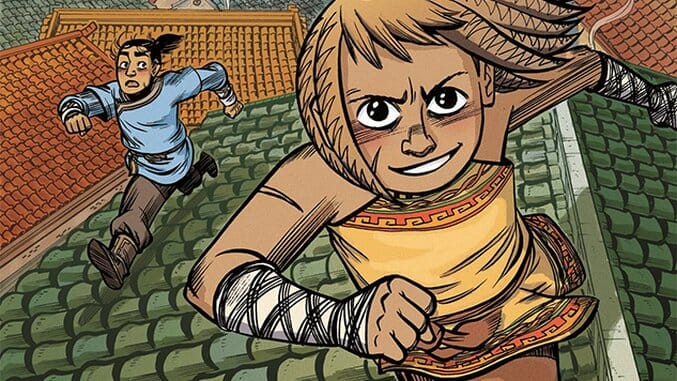Faith Erin Hicks on Her Historical Fantasy The Nameless City and the Need for More Kissing in Comics

Faith Erin Hicks’s new graphic novel, The Nameless City, abounds with political intrigue, thrilling fight scenes and tense rooftop chases. Within its pages, Hicks explores the titular Nameless City, a contentious space with a long and mysterious history. This graphic novel is the first book in a planned trilogy, focusing on the growing friendship between the characters Kai, a young man of the society currently occupying the city, and Rat, a young woman whose family holds a long and intricate relationship with a land perpetually assuming new identities. These relationships allow Hicks to explore how vastly different people embrace the world they call home, but it also presents explorations of political occupation and generations-long resentments, both of which have plenty of resonance in today’s landscape.
We talked with Hicks about the process of creating this new fiction, as well as explored her artistic evolution, the change in her process that resulted in this graphic novel and more. And given that Hicks’ work has encompassed a host of genres, we also discussed which ones she’d like to tackle in future projects.![]()
Paste: The Nameless City’s prologue is dedicated to establishing just how the namelessness of the Nameless City came to be. When did the notion of having a setting without a name (or with so many names that it became effectively nameless) resonate with you?
Faith Erin Hicks: Like many things that happen during the creative process of making a story, the idea of the City being nameless came about by coincidence. Originally I wanted the City to have an original name, perhaps one that was obliterated by time. I was reading about the history of Beijing, and how it had been named and renamed over its long history, and I thought, well, maybe this is something I can use as a theme in the story. This idea that the City had been named something different by conqueror after conqueror, so as an act of passive resistance, the City’s natives, people who didn’t identify with any outside nation, just refuse to call it by any name.
Paste: The layout and architecture of the Nameless City both loom large throughout the graphic novel. How did you go about creating a unique look for the space? Were you looking to any specific periods and styles of architecture, or blending across regions and periods of time?
Hicks: I did a lot of research into Chinese architecture. Every background drawn in The Nameless City was referenced from real life, although I did occasionally alter the designs of things in service to the story. I looked a lot at photos of the Forbidden Palace, and also well-preserved Chinese towns like Suzhou and Fenghuang. Although the setting of The Nameless City is specifically inspired by 13th Century China, I wanted the City itself to have an ancient, multicultural feeling to it, as though it had been built and rebuilt over the centuries by many different kinds of people.
Paste: Throughout the comic, there are questions of cultures colliding, and of the resentments that can fester between different aspects of a region’s population. What was your process like for creating the larger world in which The Nameless City thrives?
Hicks: I did research into The Silk Road and was fascinated by the history of this great trade route, and how people from all these different nations who often times were at war with each other, would interact under the banner of commerce. That research became the spine of the world I built for this comic, this idea that there were so many different people who might hate each other, but in the name of making a living wage, chose to live civilly (for the most part) side by side. There are dissent and fear among some of the populace of The Nameless City, but I wanted to present it as a functioning society, albeit one with deep-rooted problems.

The Nameless City Interior Art by Faith Erin Hicks and Jordie Bellaire
Paste: In some ways, the Dao’s rule over The Nameless City is presented as relatively benign; in others, it seems like a case of making the best of a bad situation. How did you balance exploring multiple facets of an ethical gray area without shifting the focus too far from the friendship between Rat and Kai?
-

-

-

-

-

-

-

-

-

-

-

-

-

-

-

-

-

-

-

-

-

-

-

-

-

-

-

-

-

-

-

-

-

-

-

-

-

-

-

-










































